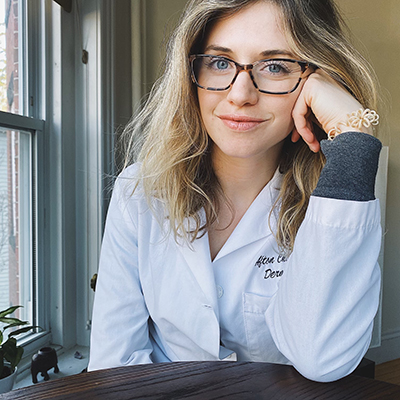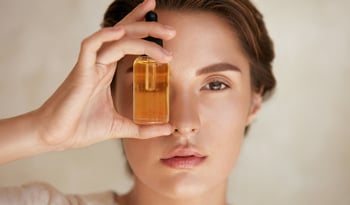Should I Be Using Probiotics and Fermented Ingredients In My Skincare?
DISCLAIMER:This blog does not intend to provide diagnosis...
- In this article:
- What Is the Skin Microbiome?
- Probiotics and Fermented Skincare Ingredients
- What You Need to Know About Probiotics and Fermented Skincare Ingredients

To understand why probiotics and fermented ingredients are trending in skincare, you first have to understand the microbiome. The skin microbiome is currently a hot topic in dermatology and is definitely worth knowing about.
When people talk about the microbiome, they are referring to all the microorganisms living in and on the body, such as bacteria, fungi, and viruses. For the most part, these microscopic organisms are not harmful to us and actually play an important role in our normal health and functioning. The microbiome helps provide nutrients that we cannot make or break down, it influences our immune system and even wards off bad bacteria. The microbiome is enormous and complex—you may have even heard that bacterial cells in the human body outnumber human cells by more than ten times! In addition, everyone’s microbiome is unique, so the composition of bacteria living on me will be different than what is living on you. It can be altered by things like what you eat, who you are around, your behavior and environment, and antibiotics. Because of the complexity, there is still a lot to learn, but it’s a fascinating topic that definitely has health implications.
What Is the Skin Microbiome?
The skin microbiome refers to the microorganisms that live specifically on the skin. It’s a relatively new domain of medicine that we’re still exploring and understanding. For example, if you look at a graph of the published articles on the skin microbiome in the scientific literature, you can see that the list of publications starts to jump around 2010 and continues to rise today. Before that, there wasn’t a whole lot of research being done in this field. I bet in the next ten to twenty years we will see more products and treatments aimed at the skin microbiome.
There are early studies that suggest alterations in the microbiome (“dysbiosis”) can be associated with diseases like atopic dermatitis, seborrheic dermatitis, psoriasis, perioral dermatitis, and other skin conditions, but it is still too soon to know how to best treat this. Furthermore, the skin microbiome can be influenced by many things, like frequent washing, skincare products, and antibiotics.
Probiotics and Fermented Skincare Ingredients
With all the interest in the skin microbiome, probiotics and fermented skincare ingredients have been coming into the spotlight. Probiotics are live bacteria or yeast that are considered to be “good bacteria.” You probably are aware of some of the fermented foods that contain probiotics, such as kefir, kombucha, yogurt, sauerkraut, miso, and kimchi. The idea behind probiotics is that by taking (or applying) them, you are delivering good bacteria to help create a healthy ecosystem for your body. Right now, we don’t totally understand which bacteria, or combinations of bacteria, are best to put on the skin to help improve the microbiome. One other potential issue with topical probiotics is that it is hard to formulate these products so that the good bacteria are allowed to survive, while still making sure that bad bacteria don’t contaminate the product. For example, most skincare products have preservatives added to them to kill bacteria so that the products remain safe for use even if they sit on your bathroom shelf for a long time.
Lactic Acid
Fermented products contain probiotics that go through the process of fermentation, ultimately creating lactic acid and other sugars and vitamins. These byproducts can have benefits for the skin. For example, lactic acid is a gentle alpha hydroxy acid (AHA) that is beneficial in exfoliating the skin and improving skin tone. Lactic acid shows up in a number of skincare products and is a good one to look out for.
Kojic Acid
A notable fermentation process in Japan uses Aspergillus oryzae fungi to make sake, miso, and shoyu. One of the resulting products is kojic acid. Kojic acid is a well-known skincare ingredient that helps treat hyperpigmentation, and is recommended by dermatologists as one of the potential cosmeceuticals for the treatment of melasma.
Galactomyces Fermentation Filtrate (GFF)
Galactomyces Fermentation Filtrate (GFF) is another product of sake fermentation. It was discovered to have skin benefits because the elderly sake brewers were noted to have smooth, wrinkle-free skin on their hands, but not their faces. GFF has been shown in clinical studies to decrease pigmentation, sebum, and inflammation in the skin. In addition, sake extract has been shown in clinical trials to block melanin (pigment) production, resulting in skin lightening after just 7 days. GFF has therefore become a popular ingredient in K-beauty products to help brighten and even out skin tone.
What You Need to Know About Probiotics and Fermented Skincare Ingredients
I do think probiotics and fermented skincare products have definite potential for improving hyperpigmentation and skin tone. This is supported mechanistically and by scientific literature. The question though is how do these products affect the skin’s natural resident microbiome? The products could help promote diversity of the natural skin flora, which could be a good thing. Alternatively, they could inadvertently contribute to microbial overgrowth or “dysbiosis.”
For example, there are some concerns that GFF can promote an overgrowth of the normal Malassezia yeast that lives on our skin. This type of yeast usually doesn’t cause problems on the skin, but if the balance is off and there is too much, excessive Malassezia can lead to seborrheic dermatitis, tinea versicolor, and pityrosporum folliculitis, also known as fungal acne.
It gets complicated because everyone’s natural skin microbiome is different, so what may be okay for one person, may not work for another person. What is the best way to know? You may have to try it for yourself and see how it goes. Eventually, I’m hopeful that we’ll have more knowledge to help guide our decisions in choosing these products.

 By Dr. Afton (Chavez) Cobb M.D., F.A.A.D.
By Dr. Afton (Chavez) Cobb M.D., F.A.A.D.


